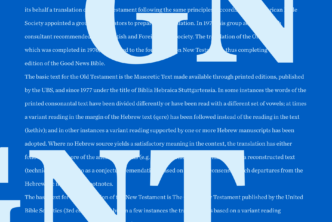Hebrew doesn’t come easy for most—it certainly didn’t for me.
While in my Hebrew classes in seminary, I set aside one full day a week to study it, trying my best to memorize the piles of vocabulary words my professor assigned and learn all the rules.
And yet even the Hebrew aleph bet was tricky—I still confuse gimmels and nuns because of their similar shape.
That’s why I find Learning Biblical Hebrew, Reading for Comprehension: An Introductory Grammar so intriguing (and wish we used it in seminary!).
The authors approach learning Hebrew not as a series of facts to memorize but as something alive, with a personality you can get to know and tendencies you can begin to predict. The lessons build upon each other in a way that mimics how we learn our native tongue.
Their goal? Help students remember Hebrew for the long haul.
For example, in the excerpt below the authors help students understand what their vocab cards are preparing them for. They introduce triconsonantal roots that form the basis of Hebrew words and convey their core meaning.
Here they present some of the basic components added to the front and back of words to augment that meaning and help students learn words intuitively.
***
In the Hebrew language, most words have a three-consonant base called a root that provides the core of meaning. This root is essentially an abstract concept represented only by consonants (e.g., שׁמע “to hear”).
In order to form actual words, the root must be combined together with vowel patterns that refine this meaning. Consonants can also be attached to the front and/or back of the root to further modify meaning. In this way, the abstract concept of the root is supplemented by vowel patterns and/or added consonants to create verbs, nouns, and adjectives that are related to the core idea of the root. For example, the following verbs (vb.) and nouns (n.) are all formed from the root שׁמע.
Because the root is merely an abstraction and can never be vocalized without the vowel patterns necessary to pronounce it, you will never memorize just the root consonants. Hebrew grammars teach vocabulary using a simple form of the verb as a representation of the core meaning. For example, the word שָׁמַע is listed in your vocabulary with the definition “to hear,” even though this form technically means “he heard.”
In your vocabulary, you can concentrate on the abstract meaning (“to hear”) because we will learn the various verb forms separately. All other vocabulary words derived from these roots (e.g., nouns, adjectives, adverbs) will appear in your vocabulary as fully developed words like those represented above (e.g., מִשְׁמָע “thing heard”).
Recognizing the triconsonantal root in the words you encounter allows you to make associations between words that are related in meaning so that you can build your vocabulary. It also helps you more quickly discern the meaning or function of individual Hebrew words based on the vowel patterns and additional consonants that are used in the formation of these words.
Eventually, you should reach a point where you can intuitively sense the meaning of an unfamiliar word because you recognize either the base meaning of the root or a familiar word structure.
***
Learning Biblical Hebrew presents comprehensive concepts to first-year students, then reviews and deepens understanding for second-year students.
And though written for Hebrew competency, it’s well suited for students with different learning styles and objectives.
By focusing on lifelong retention rather than rote memorization, this resource won’t just help you learn biblical Hebrew . . . it will ensure you remember it.
***
Learn more about Learning Biblical Hebrew, Reading for Comprehension: An Introductory Grammar and grab your copy today.





